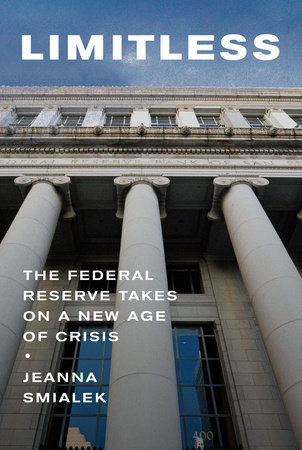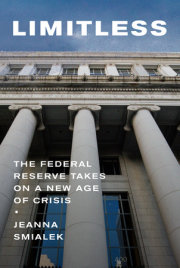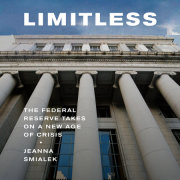Chapter 1
The Before Times
“Normal” may vary from time to time.
—Daniel Tarullo, then a Fed governor, December 2014 Federal Open Market Committee meeting transcript
The school gymnasium in East Hartford, Connecticut, did not share much in common with the swanky Washington, D.C., dining establishment that Jerome Powell had frequented before becoming chair of America’s Federal Reserve.
At the Metropolitan Club in D.C., which he had once visited regularly for work lunches, gentlemen were expected to wear ties. Real ones. String ties, ascots, and turtlenecks were “not acceptable,” the bylaws of the members-only institution sniffed. If a gentleman were to make the faux pas of arriving without appropriate neckwear, something fitting would be loaned to him.
At Silver Lane Elementary School, where Powell had traveled on a late November morning in 2019, it was obvious that many of the jacket-wearing attendees had donned them for the chairman’s benefit. Schoolchildren wore purple polo shirts, and at least one person had on blue jeans. The guest list, too, couldn’t have been more different. He had usually held one-on-one meetings at the Club, joining high-ranking government officials—generally white men—for American fare served beneath chandeliers. Nearby diners were often known figures from exclusive backgrounds. Women, banned for the bulk of the club’s 150-year history, remained relatively scarce.
That gray autumn day in Connecticut, a diverse set of manufacturing workers, teachers, and community advocates sat around a horseshoe of cafeteria tables hidden underneath black tablecloths. They spooned Mexican rice and roasted chicken from a local grocery store out of buffet-style aluminum steamers. Powell went back for seconds.
The chair of the Federal Reserve was the son of a D.C. lawyer, had been a private equity power player in his middle age, and was perhaps the mightiest economic policy maker in the world at sixty-six. That he had chosen to forsake Washington’s more sumptuous halls for a squeaky-floored gym, where the waxy scent of crayons lingered in the air and industrial bulbs cast a cold white light on the proceedings, said something important about his priorities at the central bank he was quietly reshaping.
The Fed had ascended to become the nation’s most important economic institution by the early twenty-first century. It guided the economy by setting interest rates, the price of money. It lowered rates to encourage lending and spending when the economy was weak or raised them to slow it down when consumption and hiring were running hot. It was a technocratic job, but an important one with big consequences for the American population. The Fed used its policy to achieve the two main goals Congress had assigned it: keeping inflation low and fostering full employment. Prosperity turned on whether it succeeded.
The Fed’s role in society didn’t stop there. As of 2019, it also regulated and supervised the nation’s largest bank holding companies, monitored financial stability, managed the nation’s cash supply and core payments system, and performed extensive economic research. Its officials often gave lawmakers advice, typically vague and nonpartisan, about the national debt or the importance of an unfolding labor force trend. It was, effectively, the government’s largest economic and financial think tank. It also served as Wall Street’s insurance policy. The central bank had the power to backstop troubled markets in times of extreme stress by lending money and smoothing over trading in hard-to-sell financial assets, a role it had filled most dramatically during the financial crisis that had rocked the world in 2008.
It was a big job, but the Fed was a big institution. It consisted of twelve regional banks scattered across the country and a Board of Governors in Washington, D.C. The regional Fed branches kept commercial banks in their districts supplied with cash, supervised those banks, and employed economic researchers. Regional bank presidents took turns voting on monetary policy—five had a vote at any given time, and one of those was always New York—and held a seat at every policy-setting Fed meeting. The presidents were selected by reserve bank boards, which consisted of local businesspeople and nonprofit representatives, and were confirmed to their posts by Washington-based officials. They typically stayed in their jobs for as long as they wanted, with some serving for decades. The reserve branches were set up like private corporations, though they functioned in the public’s interest.
If the semiprivate regional banks were the Fed’s limbs, the Washington-based board was the beating heart of the system. It was fully public, with its seven governors appointed by the president and confirmed by the Senate. The Fed’s chairperson, vice-chair, and vice-chair for supervision were all governors, and board members had authorities that presidents lacked. They held constant votes on monetary policy, and they alone regulated the nation’s largest banks and voted to create financial rescue programs in times of crisis. They also had very long terms: fourteen years if served from start to finish, though people rarely stayed for full stints. Thanks to how powerful the positions were and how long they could last, the White House typically treated appointments to the Fed Board with gravity, carefully vetting candidates and floating names in the press to make sure they didn’t stir up too much controversy.
Powell had first come to the Fed Board in 2012, when President Barack Obama appointed him as one of its seven governors. He was chosen, funnily enough, partly for his Republican politics. The president’s latest nominee had failed to pass the Senate Banking Committee, his chances tanked by a Republican senator, and the Democratic administration felt it needed to make a bipartisan offering to the Senate to get a candidate confirmed. As Obama officials searched for qualified candidates to appoint to two open Fed seats, they landed on Jeremy Stein, a financial regulation expert and Harvard University academic who would bring needed expertise to the Board. Other economists insisted that Stein was a Republican, but when it turned out that he was actually a registered Democrat, the administration decided it wanted him anyway. Officials briefly contemplated pairing Stein with Richard Clarida, a genuine Republican who was a professor at Columbia and adviser at the asset-management behemoth Pacific Investment Management Company, or Pimco. Clarida, unfortunately for them, decided that he didn’t want to leave his job. They homed in on Powell.
The lawyer and financier had cut a low profile in the Washington policy scene until then, but he was an attractive pick for the political horse trade. He was a moderate Republican, and he was working at a think tank called the Bipartisan Policy Center when the administration came calling, earning $1 per year for his efforts, something unheard of at the institution. He had wanted to get a toehold in the Washington policy discussion, and he had already made tens of millions of dollars in his private-sector career. The debt ceiling crisis of 2011 had given him a major project. That year, Congressional conservatives threatened not to raise the nation’s borrowing limit, which would have prevented the country from continuing to pay its bills. As a former Treasury official and a clear public speaker, Powell had been able to wage a sober informational campaign detailing exactly when the debt limit would be breached and what that would mean.
Powell had compiled spreadsheets that allowed him to guess the “X Date” when the government would no longer be able to make payments. The government did not produce its own projection, so journalists began to regularly reference the estimate. In a seemingly endless string of meetings, Powell, a trim man with tidy suits and side-combed hair, explained the timeline to senators without hyperbole or judgment, using the same no-nonsense tone that had served him well through long years of private equity dealmaking. The national debt was on an unsustainable path, he agreed, but there was no real choice. Defaulting would pose a huge risk to markets, the economy, and America’s standing in the world order.
Republicans got the message, and though it came late in the game, the ceiling was lifted. Powell had been just one voice urging lawmakers to make that evidence-based choice, but the episode had left him looking savvy and, compared to some of his party colleagues, sane.
“Secretary Geithner and Treasury staff got to know Powell well during the debt limit debate when he was one of the most helpful Republican validators for their views,” White House economic officials wrote in a memo to President Obama suggesting his potential nomination to the Fed. Still, Powell was not a credentialed academic economist or a storied monetary thinker.
“Perhaps the biggest downside of Powell is that he would bring less thought leadership and creativity to the Federal Reserve than some other candidates might,” the memo went on. “Nevertheless, he brings many other strengths” and “is well above average compared to previous Fed governors.”
People seek out big government jobs for different reasons, and Jerome Powell seemed to be driven to the higher reaches of American bureaucracy by some combination of a do-gooder attitude and genuine curiosity. The big questions plaguing the world had always piqued his interest. As a Princeton undergraduate in 1975, he had written a thesis on what could spur societal change in South Africa, then enforcing a gruesome apartheid segregation that discriminated against Black people. He had long seen public service as a high calling and a goal, inspired by lessons from the nuns of his Catholic school youth and by familial example. His father, a Washington-based lawyer, had been unable to take a job in the Nixon administration because of financial constraints. The Powell clan was rich by any reasonable standard, but the family of eight didn’t feel it could bear the pay cut.
The younger Powell had set out to make a fortune large enough to permit a career that flitted between the private sector and government, and he had succeeded.
After attending Georgetown’s law school and beginning his professional life as a Wall Street lawyer at Davis Polk & Wardwell and the firm Werbel & McMillen, Powell in 1984 became an investment banker at the elite firm Dillon, Read & Co., focusing on financing and mergers and acquisitions. The following year, he married Elissa Leonard, a Harvard graduate from Rockville, Maryland, who was then writing a science program for PBS. Like Powell, Leonard was the daughter of socially engaged parents: Her father, a public health administrator and science fiction writer, had marched from Selma with Martin Luther King, Jr., in 1965, and her mother was a public school librarian and later a volunteer art museum docent. Powell and Leonard were known by friends and acquaintances as lovely, charming, active in the world around them. They were the kind of people who seemed destined for higher things.
When George H. W. Bush was elected president, Powell’s boss at Dillon, Read & Co., Nicholas F. Brady, became secretary of the Treasury Department. Powell, by then in his late thirties, decided to follow Brady to Washington in 1990. He became assistant secretary at the Treasury, and, at thirty-nine, moved up to become undersecretary for finance. Powell’s various positions put him at the center of government debt issuance, giving him a bird’s-eye view of the backbone of global bond markets. They also earned him a reputation as a master consensus forger.
As assistant secretary for domestic finance in 1992, Powell had helped to orchestrate a solution when it became clear that the bank Salomon Brothers had been rigging part of the Treasury market. Salomon was then a primary dealer, one of the few select institutions that could buy bonds directly from the government, and it was one of the largest financial firms of its time. If the government punished Salomon for its misdeeds by revoking its primary dealer status, it risked toppling the firm and causing it to dump assets on the market in a rush, which would have been dangerous for the broader system. Over a frantic weekend, officials had wheeled and dealed to keep Salomon in the fold, with some restrictions, while replacing its leadership with Warren Buffett, the famous investor who was then one of its major shareholders. The thorny decisions he was involved in forced officials to exercise one of the principles that would define Powell’s later career as a policy maker: relentless pragmatism. If Treasury had made an example of Salomon, it could have sparked wider economic damage. Keeping it alive looked bad, but it was less painful.
“It still gives me nightmares,” Powell would say of the episode a quarter century later. Immediately following the disaster, Powell shepherded a government report calling for big changes to the way that Treasury securities were sold to fix the vulnerabilities that had allowed the problem to develop. Quoting one of his counterparts on that project, The New York Times reported that Powell had achieved “far more consensus” than had been thought possible while heading the committee of Treasury, S.E.C., and Federal Reserve officials.
Following his early stint in government, one that had left him respected in Washington, Powell had worked in banking briefly before moving in 1997 to Washington-based private equity giant The Carlyle Group. While his experience in government had begun to build up Powell’s reputation, his time in private equity would complicate it. Thanks to its proximity to the seat of government power and intricate web of relationships in D.C., Carlyle was the subject of frequent criticism about the revolving door between Washington and finance. Powell spent about eight years there, closing or helping to close deals worth hundreds of millions of dollars. His time at Carlyle, and the debt-laden companies he left in his wake, would provide grist for his critics for decades.
After he left Carlyle, Powell continued to dabble in private equity before making his way into the Washington think tank world and then to the Fed. Once he had been confirmed to the central bank, he chaired a range of committees and kept a low profile as he brought himself up to speed on a complicated array of topics. Monetary policy was anything but simple in the lackluster economic era that followed the 2008 financial crisis. Before he began to deliver speeches or appear in public, Powell spent long months studying, asking Fed economists for briefings, and researching the issues of the day so thoroughly that he built a reputation among the staff for intellectual modesty and extreme meticulousness. Powell might not have been a trained PhD economist, but he was bent on becoming an economic expert.
The job was an interesting one, and over the years Powell earned the esteem of Janet Yellen, then the chair, and his other colleagues for his willingness to take on assignments that ranged from large and consequential to small and mundane. He weighed in thoughtfully on policy decisions. He helped to monitor reserve bank affairs. He pitched in on minor building and budget issues at the Fed’s Washington headquarters. Powell found life as a Fed governor frantically busy, but he was the type of person who thrived on activity. He still managed to spend time with his wife and teenage children at their home in Chevy Chase, Maryland, where he and his family were active community members, and to ride his beloved road bike to and from work and around the paved paths that crisscross the Washington metro area. He also golfed and read for fun (spy novels by John le Carré were a favorite).
Copyright © 2023 by Jeanna Smialek. All rights reserved. No part of this excerpt may be reproduced or reprinted without permission in writing from the publisher.






